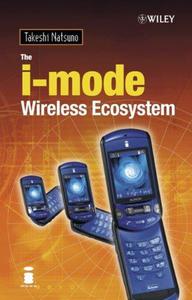 The i-mode Wireless Ecosystem By Takeshi Natsuno(auth.)
The i-mode Wireless Ecosystem By Takeshi Natsuno(auth.)2003 | 179 Pages | ISBN: 0470859083 | PDF | 2 MB
i-mode is the packet-based service for mobile phones offered by Japan's leader in wireless technology, NTT DoCoMo. Unlike most of the key players in the wireless arena, i-mode eschews the Wireless Application Protocol (WAP) and uses a simplified version of HTML, Compact Wireless Markup Language (CWML) instead of WAP's Wireless Markup Language (WML). Ever since its introduction in February 1999 i-mode has been the most successful mobile internet technology of the World. i.e. the quickness by which the technology has spread over Japan. In Japan, the number of i-mode users is close to a sensational 13 million. This means that 10% of Japan's total population are using i- mode after not even 2 years of its existence. As a progression from his first book i-mode Strategy the author describes how i-mode has evolved. He focuses on the i-mode ecosystem (the metaphor he uses to describe such a self developing business) from concept to reality, the effect of i-mode, the evolution of Cell phones, partnerships with real businesses, such as the collaboration with Coca Cola in Japan, the struggle for dominance in the net business and the globalisation of the i-mode business arena from a Japanese only ecosystem to the global arena. The author is the most highly respected expert in this field. The i-mode Wireless Ecosystem is a must for everyone wanting to know more about NTT DoCoMo and how it has sustained its business model. Discusses the globalisation of i-mode featuring the key points such as origin, development, international expansion and the role of partners etc. Through using his own company's strategy and experience the author explains the value of creating a business 'ecosystem' and the benefits of co-operation between various mobile operators Content: Chapter 1 A Value?Generating Ecosystem (pages 1-31): Chapter 2 The i?mode Effect (pages 33-63): Chapter 3 Ever?Evolving Mobile Phones (pages 65-85): Chapter 4 Connection with the Real and the Realistic (pages 87-111): Chapter 5 i?mode and the Battle for Net Supremacy (pages 113-147): Chapter 6 i?mode for the World (pages 149-163):



![S.T.A.L.K.E.R. 2 / STALKER 2: Heart of Chornobyl - Ultimate Edition (2024) [+UPDATE 23.12.2024 - v1.1.3] ElAmigos / Polska wersja językowa](https://i.postimg.cc/Zqd8RWGY/UZG8PBE.jpg)



















































![David Gilmour - Luck and Strange (2024) [FLAC]](https://i.imgur.com/everaBc.jpeg)
![Męskie Granie Orkiestra - Męskie Granie 2024 (2024) [FLAC]](https://i.imgur.com/FAyOxrM.jpeg)
![The Rolling Stones - Hackney Diamonds (2023) [FLAC]](https://i.imgur.com/wCkyyUN.jpg)
![Lady Gaga - Harlequin (2024) [FLAC]](https://i.imgur.com/dcgIA8D.jpeg)
![Natalia Kukulska - Dobrostan (2024) [FLAC]](https://i.imgur.com/bdljG3O.jpeg)
![Kaśka Sochacka - Ta druga (2024) [FLAC]](https://i.imgur.com/hORQKvn.jpeg)
![Kuba Sienkiewicz - Pani Bóg (2024) [FLAC]](https://i.imgur.com/qijCx8Z.jpeg)
![Lanberry - Heca (2024) [FLAC]](https://i.imgur.com/8P7QfeR.jpeg)
![Sara James - PLAYHOUSE (2024) [FLAC]](https://i.imgur.com/m4f8OKg.jpeg)
![Grzegorz Hyży - EPILOG (2024) [FLAC]](https://i.imgur.com/8DA2sBr.jpeg)
![Myslovitz - WIECZORAMI CHŁOPCY WYCHODZĄ NA ULICE (2024) [FLAC]](https://i.imgur.com/l9mMtIG.jpeg)
![Krzysztof Zalewski - ZGŁOWY (2024) [FLAC]](https://i.imgur.com/vh48RAc.jpeg)
![Krzysztof Cugowski - Wiek to tylko liczba (2024) [FLAC]](https://i.imgur.com/SBzgqe2.jpeg)
![Nosowska - Kasia i Błażej (2024) [FLAC]](https://i.imgur.com/mObvVXQ.jpeg)
![sanah - Pianinkowe Kaprysy (2024) [FLAC]](https://i.imgur.com/pVjjPAa.jpeg)
![Kwiat Jabłoni - Pokaz slajdów (2023) [FLAC]](https://i.imgur.com/diERHfZ.jpg)
![Robert Cichy - Spacer po Warszawie (2024) [FLAC]](https://i.imgur.com/ixleU9o.jpeg)
![Viki Gabor - Terminal 3 (2024) [FLAC]](https://i.imgur.com/Q1KCnDs.jpeg)
![Sanah - Kaprysy (2024) [FLAC]](https://i.imgur.com/71OZm4h.jpeg)
![Męskie Granie Orkiestra - Męskie Granie 2023 (2023) [FLAC]](https://i.imgur.com/U4YHo8d.jpg)




